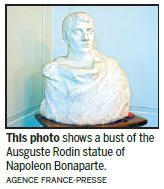The forgotten history of Rodin's Napoleon, found in a New Jersey meeting room
WASHINGTON - Napoleon Bonaparte and Auguste Rodin are both household names, but a bust of the French emperor created by the master sculptor faded into oblivion in a town in the United States, only to be discovered by chance.
The white marble statue had been visible in the meeting room of the borough hall of Madison - a municipality of 16,000 people in New Jersey - for the past 80 years.
But in 2014, a 22-year-old art history student, recruited to take inventory of the building's artworks, came across the bust and noticed a signature that read "A. Rodin" in the sculptor's style.
Mallory Mortillaro consulted experts and dug into archives, determined to confirm whether it was a genuine Rodin.
She was eventually pointed in the direction of the Paris-based Comite Auguste Rodin, the leading authority on the father of modern sculpture.

And the mystery was solved: In the group's collection of documents was a photograph showing Rodin posing with the bust, which was believed to have been lost.
In September 2015, Rodin expert Jerome Le Blay traveled to Madison. He needed only seconds to confirm the authenticity of the piece, which was valued at between $4 million to $12 million.
The marble was commissioned originally in 1904 by the wife of collector John Woodruff Simpson but the deal was never completed.
Thomas Fortune Ryan, a friend of the collector, then bought the piece during a visit to Paris in 1909. Once he died, the bust was lost in 1933.
Research revealed that a merchant had bought the statue on behalf of Geraldine Rockefeller Dodge, daughter of financier William Rockefeller.
She constructed the Hartley Dodge Memorial - Madison's borough hall - in tribute to her son who was killed in 1930 in a road accident in France, and decorated the interior with works from her collection.
It is thought Rodin took inspiration from Napoleon's death mask to create the bust and also used a look-alike.
In plaster studies at the Rodin Museum in Paris, Napoleon's face is "a bit more warrior-like", Le Blay said. "In the final marble, he has a more questioning side, much more evasive."
Agence France-presse
(China Daily 10/25/2017 page12)














